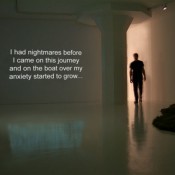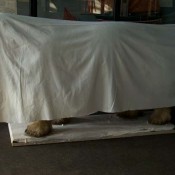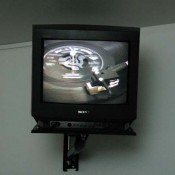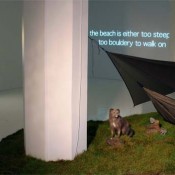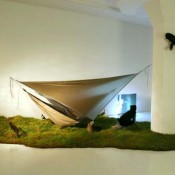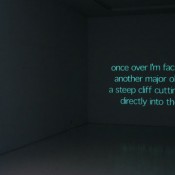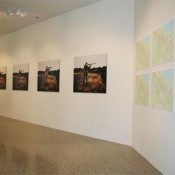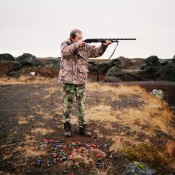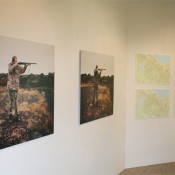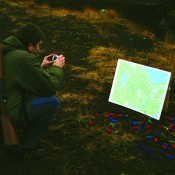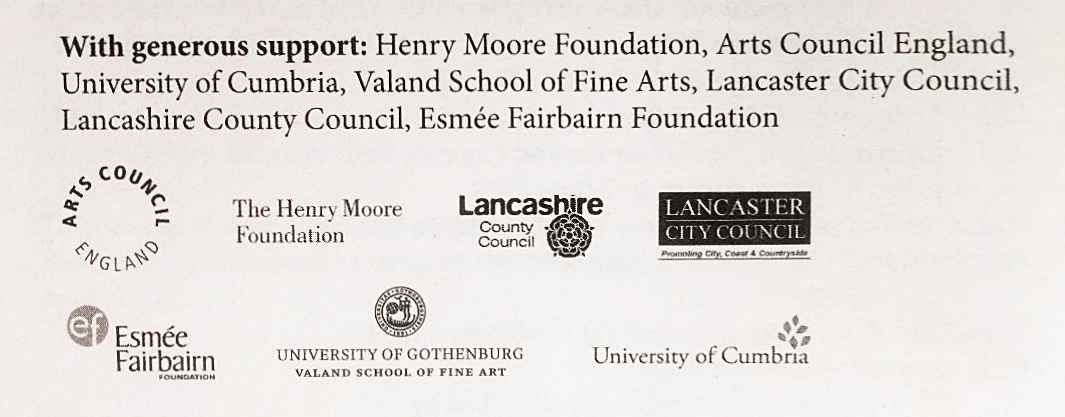All posts by Patricia
Knutur Arnar Oskarsson
Johannes Gislason
Olafur Orn Petursson
lullabies/vöggurvísur
a(fly)
In Uncertainty in the City (2008-10) commissioned by the Storey Gallery in Lancaster, we moved from the heart of the home as examined in (a)fly (2006), to the urban peripheries – the wall cavities, the roof spaces, the broken mortar and gardens, to examine human responses to other hidden societies, living in our midst, considering them simultaneously in two ways – one, as unselfconscious communities of fauna going about their disparate business within and around our homes – and two, as an incongruous and contradictory human construct, commanding and combining in tension, a wide and disparate range of affect. The responses were wide-ranging and included fear, anxiety, irritation, disgust, wonder, a sense of privilege and more…
Uncertainty in the City was a research project predominantly based around Lancaster and the North of England. In this project we focused on margins of human tolerance, where a range of opinion or views provides a promising field of inquiry, as indicative of contradictory and certainly unresolved schisms in our social and socio-environmental fabric. Where such diversity of response to a phenomenon exists, it suggests there may be some susceptibility to reappraisal and change. Of course variance of opinion and perspectives are not by definition a problem, but where those opinions are embedded over a long time and lie unchallenged, we see merit in shuffling the pack and seeing new juxtapositions – inviting new readings and opportunities for understanding and behaviour.
Most of our research was conducted in 2009-10 under the banner of Radio Animal, a mobile radio unit and website we designed to gather and disseminate information about the subject (see radio animal here on left). The website continued to develop and function as a repository up to the opening of the exhibition (2010) – and continues as a public resource hosting a 360º virtual tour of the installation:
Ghost Road Tasmania
Research Fellowship July-August-September 2002
In 2002 Snæbjörnsdóttir/Wilson were offered one of the first Arts Council England International Fellowship Awards to Australia.

Our host institutions were the Victorian College of the Arts in Melbourne and the Ruskin School of Art and Design, Oxford University. We topped and tailed a three-month residency in Australia with two week-long sessions in Oxford.
At the Centre for Ideas at the VCA we were looked after by Karen Lyons and Nikos Papastergiadis, (who’d recently moved on, but nevertheless was actively involved in ensuring the smooth running of the residency)
Both the preliminary visit and the wind-up visit to Oxford were hugely useful, enabling us amongst other things, to meet keepers and curators in the Oxford University Museum who helped us find our way through those parts of the collections of particular interest to us. We were enormously well looked after and entertained there by Paul Bonaventura who throughout the fellowship was enormously helpful.

Whilst we were in Australia we quickly identified what it was that we wanted to research, this being the prevailing fanatacism and the historical contention surrounding the Thylacine or Tasmanian wolf. Being in the area, we were able to set up meetings and interviews with specialists in Melbourne and in Tasmania. These included an animal behaviourist and commentator on the history and philosophy of science, a parks & wildlife manager, a museum curator, an environmentalist partnership, a veteran trapper, a contemporary ‘hunter’ of the animal, a geneticist, all of whom are engaged and driven by aspects and possibilities pertaining to this believed-to-be extinct creature.

This period of intense research was made possible to us by the International Fellowship. Not only were we given travel costs to get us there and to travel whilst in Australia but the association with the host organisations meant that from the outset there was a sense of support and connection both personally and institutionally.
We found that the Fellowship enabled us to develop and extend growing tendencies within our practice towards more collaborative and process-based outcomes. We enjoyed identifying other interested parties and enlisting their cooperation, knowledge and insights, all of which remain theirs within the structure of the work, but which resonate distinctly when put in what is a ‘collective’ context.
Because of this we gained confidence in this direction and it undoubtedly assisted in the evolution of our practice. In addition it further bolstered our belief that collaboration and the pooling of knowledge and experience is enormously beneficial in the processes of observation and discovery and consequentially in making art.

The previous year (2001) we took a residency in Greenland funded by NIFCA. This was a country we had planned to visit for a number of years in relation to work and Australia, although a different continent and at the opposite side of the Globe, we felt shares many characteristics with areas we have visited in the sub-polar north.
We were conscious of the similarly sparse and predominantly coastal distribution of a population, marginalized by an inland desert.
We were aware that these two ancient landmasses are the largest islands on earth. Both too have an extant aboriginal population trying to maintain a subsistence culture on the one hand whilst on the other, negotiating a living relationship with settlers.
As was the case in Greenland, we were keen to consider the symbolic functions of particular animals that inhabit and have inhabited the Australian bush.
Without wishing to anticipate any particular outcome of the residency we were conscious that certain environments mobilise and sustain the respect of those who live there whilst others, generally from more temperate zones, can engender an indifference in their inhabitants to nature and to life, (particularly non-human life) in general.
(a)fly extends the artists cycle of projects examining human relationships to landscape and environment by way of observing the human/animal interface. In this instance they concentrated on domestic animals within an urban environment. The title (originally a fly in my soup), makes reference to an often awkward and sometimes problematic collision between culture and nature. By taking the city and even the domestic environment as the coalface of this exchange it staked out new ground for a reappraisal of the way we relate to the wider environment as revealed through this particular set of relationships.
The basic structure of the project is a survey, mapping pets in the inner city area of Reykjavik. Four ptarmigan hunters turned their guns on maps, at a distance of 50 metres thereby selecting specific residential properties within Reykjavík 101. The owners were contacted and from this process, pet owners in the area were identified.
A key component of the project is a series of photographs taken of the environments (homes) of pets either constructed by owners or chosen by pets themselves within the environs of their hosts.
Our research found many restrictions and regulations related to the keeping of animals and pets in Reykjavík, some of which are very different from other cities that we know in the U.K. or USA. In Reykjavík at that time, dogs were technically forbidden by law. You can apply for a license (that costs approximately 15,000 ISK or £200). With the license come obligations to micro-chip your dog, and show proof that it is wormed and vaccinated by a vet on a regular basis. Around this time a similar law was passed by the City Council in Reykjavík regarding the keeping of cats.
Professor Ron Broglio, Department of English at ASU wrote the following about the project.”…This same absence of the animal world is evident in the current project a fly in my soup as in other projects by Snæbjörnsdóttir/Wilson. In (a)fly [the artists] travelled to Iceland and photographed the space in peoples’ homes where their animals dwell. It may be a dog bed, a cat corner, a fish bowl, etc. The photographs do not include the animal – only their setting. As with nanoq, the absence of the animal haunts their work. In this case, viewers must negotiate the (often oedipalized) human expectations of a pet with the question of what the animal perceives. There is an uncomfortable fit between the animal’s residual space in the human’s habitat and the photograph which makes the animal’s place central. [They do not] photograph the well-kept family room or the front façade of the house; rather, they photograph corners and washrooms, stairs and ledges. Wilson and Snæbjörnsdóttir force the question, “From whose umwelt are we seeing this place?” No longer are we opening the animal up in order to name and know it. Rather, knowledge comes from the displacement of perspective and from the uncomfortable haunting provided by the surface of another world that lingers as a remainder in our own.”
Exhibited: National Museum of Iceland and Reykjavík City Library as part of Reykjavík International Art Festival in 2006. Also in Gothenborg Konstmuseum , Sweden (2007)
